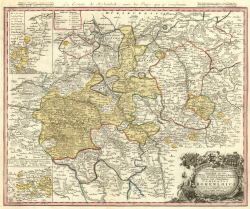Hohenlohe-Neuenstein
| County (Principality) of Hohenlohe | ||||||||||
| Grafschaft (Fürstentum) Hohenlohe | ||||||||||
| State of the Holy Roman Empire | ||||||||||
|
||||||||||
|
Hohenlohe estates, Homann 1748
|
||||||||||
| Capital | Öhringen | |||||||||
| Religion |
Roman Catholic Lutheran |
|||||||||
| Government | Monarchy | |||||||||
| Margrave | ||||||||||
| • | 1157–70 | Albert the Bear (first) | ||||||||
| • | 1797–1806 | Frederick William IV (last) | ||||||||
| History | ||||||||||
| • | Established | 1450 | ||||||||
| • | Raised to Imperial Counts |
13 May | ||||||||
| • | Joined Franconian Circle |
1500 | ||||||||
| • | Raised to principality |
21 May 1744 | ||||||||
| • |
Mediatised to Württemberg |
12 July 1806 | ||||||||
|
||||||||||
Hohenlohe is the name of a German princely dynasty descended from the ancient Franconian Imperial immediate noble family that belonged to the German High Nobility (Hoher Adel). The family was granted the titles of Count (in 1450) and, later, Prince (see below). In 1806 the Princes of Hohenlohe lost their independence and their lands formed part of the Kingdoms of Bavaria and of Württemberg by the Act of the Confederation of the Rhine (12 July 1806). At the time of this mediatization in 1806, the area of Hohenlohe was 1 760 km² and its estimated population was 108,000. The Act of the Confederation of the Rhine deprived the Princes of Hohenlohe of their Imperial immediacy, but did not confiscate their possessions. Until the German Revolution of 1918–19 the Princes of Hohenlohe, as other mediatized families, had important political privileges. They were considered equal by birth (Ebenbürtigkeit) to the European Sovereign houses. In Bavaria, Prussia and Württemberg the Princes of Hohenlohe had hereditary right to sit in the House of Lords. In 1825 the Assembly / Diet of the German Confederation recognized the predicate of "Serene Highness" (Durchlaucht) for the heads of the Hohenlohe lines.
An early ancestor was mentioned in 1153 as one Conrad, Lord of Weikersheim. His son Conrad jun. called himself the possessor of Hohlach (Hohenloch or Hohenlohe) Castle near Uffenheim, and the dynasty's influence was soon perceptible between the Franconian valleys of the Kocher, the Jagst and the Tauber Rivers, an area that was to be called the Hohenlohe Plateau. (In 1378, Hohenlohe was sold to the Burggraves of Nuremberg ).
Heinrich I (died 1183) was the first to take the name of Hohenlohe, and in 1230 his grandsons, Gottfried and Conrad, supporters of Emperor Frederick II, founded the lines of Hohenlohe-Hohenlohe and Hohenlohe-Brauneck, names taken from their respective castles. The latter became extinct in 1390, its lands passing later to Brandenburg, while the former was divided into several branches, only two of which, however, Hohenlohe-Weikersheim and Hohenlohe-Uffenheim-Speckfeld, need be mentioned here. Hohenlohe-Weikersheim, descended from Count Kraft I (died 1313), also underwent several divisions, that which took place after the deaths of Counts Albert and George in 1551 being specially important. At this time the lines of Hohenlohe-Neuenstein and Hohenlohe-Waldenburg were founded by the sons of Count George. Meanwhile, in 1412, the family of Hohenlohe-Uffenheim-Speckfeld had become extinct, and its lands had passed through the marriages of its heiresses into other families. George Hohenlohe was archbishop of Esztergom (1418–1423), serving the King Sigismund of Hungary (later also Holy Roman Emperor and King of Bohemia).
...
Wikipedia


